
Airfix 1/1200 Bismarck
| KIT #: | 4204 |
| PRICE: | $ |
| DECALS: | None |
| REVIEWER: | Tim Reynaga |
| NOTES: | Clip together kit |

| HISTORY |
Perhaps the most
famous warship of all time, the German battleship Bismarck is one of those
ships whose legend has come to overshadow reality. Displacing more
than 50,000 tons and shipping eight massive 15 inch guns as well as an
imposing array of secondary artillery, Bismarck was indeed an awesome
weapon. According to a 1942 U.S. Office of Naval Intelligence
assessment, “Bismarck was probably as formidable as any battleship then in
service”. Yet the ship’s major claim to fame, the sinking of the HMS
Hood and mauling the battleship Prince of Wales, was a bit of a fluke.
The German task force was actually
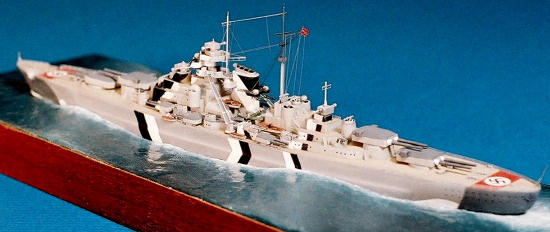 sailing
under orders to avoid
British warships in order to focus on its real mission, the destruction of
merchant shipping. As it happened they were unable to elude the Royal
Navy, and the epic pursuit, Battle of the Denmark Strait, and the Bismarck’s
dramatic final destruction have earned the ship a kind of mythical status.
sailing
under orders to avoid
British warships in order to focus on its real mission, the destruction of
merchant shipping. As it happened they were unable to elude the Royal
Navy, and the epic pursuit, Battle of the Denmark Strait, and the Bismarck’s
dramatic final destruction have earned the ship a kind of mythical status.
Still, despite its immense firepower and the valor of its crew, the Bismarck was, in the final analysis, a dinosaur. Built and deployed at staggering cost, Germany’s most famous battleship failed utterly in its primary mission: Bismarck never sank a single merchant ship. By contrast, the U-Boats, smaller and comparatively cheap to build, were to sink over 5,000 merchant ships and nearly starve Britain out of the war. Had Germany taken to heart the lessons of the First World War and abandoned the useless big gun fleet in favor of the U-Boat arm, the Kriegsmarine could have used its over 8,300 battleship sailors to man an additional 166 U-boats at the outset of the conflict—enough to quadruple the vital submarine force at a time when Britain was most vulnerable. Splendid as they were, the very size, power, and cost of the mighty Bismarck and the other battleships may well have cost Germany the critical Battle of the Atlantic.
| THE KIT |
This kit was one
of Airfix’s first 1/1200 “Naval History Series” clip-together models issued
in 1973.
I hadn’t even heard of this series until recently; apparently there
was also a Prinz Eugen, Hood, Ark Royal, Suffolk, and a Tribal class
destroyer (all ships in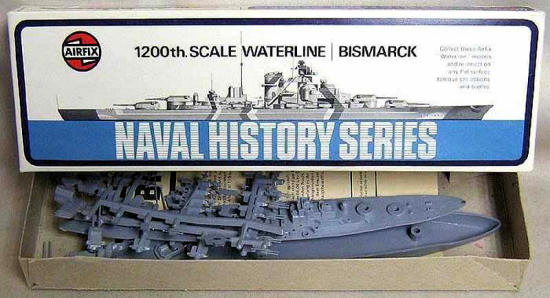 volved
in the Bismarck chase). These kits have
long been out of production, but you can often find them on e-Bay fairly
cheap (I paid less than ten bucks for this one). The 50 gray plastic
parts assemble into a basic but good looking little battleship.
volved
in the Bismarck chase). These kits have
long been out of production, but you can often find them on e-Bay fairly
cheap (I paid less than ten bucks for this one). The 50 gray plastic
parts assemble into a basic but good looking little battleship.
The waterline hull
is a single part with a solid bottom and separate single-piece main deck, so
there are none of those annoying mid-deck seams so common on larger scale
kits. This is fortunate since the raised deck planking is beautifully
delicate. In fact, it is some of the best I’ve seen in any scale—they
really got it right way back in 1973! I wish more model manufacturers
had continued this style of depiction for planked decks, so much more
effective than the overdone trench lines so often seen today. Assorted
deck hardware is also well done with bitts, hatches, vents, and other
details sharply depicted. Unfortunately, the model overall doesn’t
quite capture the graceful lines of the original. The length/beam
dimensions are right, but the hullform is too pudgy fore and aft.
Also, the armor belt is too low and the numerous portholes are missing.
Worse, the funnel, superstructures and aft turrets are placed just a little
too far back. The problem isn’t too noticeable until you get to the
fantail, which is about 20 scale feet too short as a result.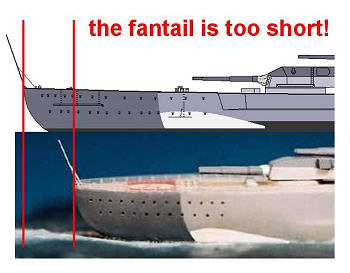
The superstructure
is simplified. The distinctive spherical hoods of the 4m type SL-8
antiaircraft directors are molded integrally with the superstructure and
represented as rounded tops on the mounts rather than as spherical shapes.
Not very good. Also, the aft mounts shouldn’t have the hoods at all
(unless you intend to build the model as the Tirpitz). The two-part
funnel is hollow with an open grating represented on the top. Main
turrets are ok, except that the barrels are about 6 scale feet too long and
the rangefinder hoods extend too far down the sides—but they are fixable.
The 150mm secondary turrets have simplified shapes and the barrels are also
too long. In addition, the ‘midships pair of mounts just forward of
the funnel should have rangefinder “ears”. Smaller parts vary in
quality from fair to excellent. The tiny Arado Ar-196 floatplane is
only so-so with no floats and an overlarge canopy, but the aircraft/boat
handling cranes are fairly good. The 10.5m rangefinders atop the
superstructures are delicately rendered, as are the masts. The best
parts are the ship’s boats, 37mm, and 105mm antiaircraft guns, which rival
comparable parts in many larger scale kits—if this kit were more readily
available I would be tempted to raid these to outfit a Revell 1/1200 scale
Scharnhorst or Gneisenau.
Incidentally, this kit is unrelated to the 1/1200 scale Bismarck/Tirpitz kits currently marketed by Revell Germany as part of their “Miniships” line. Those models seem to be reissues of the old Casadio/ESCI kit, which was mediocre at best. Though harder to find, Airfix’s model is much better.
| CONSTRUCTION |
This
is a clip-together model, so assembly was a piece of cake. The deck,
hull, superstructure, and funnel went together in a matter of minutes.
The kit parts look decent, but the bulkheads and hull sides are almost
completely featureless. The only details in evidence are the numerous
“Aztec temple” style
inclined ladders on the decks. I’ve
never been a fan of these,
but in this small scale they actually don’t look too bad, so I left them.
To add a bit of further visual interest to the plain bulkheads I added some
of the many portholes with which Bismarck was festooned. Using line
drawings of the ship reduced to 1/1200 scale on a copier as a guide, I
drilled out over 140 of these things using a tiny #77 bit chucked into my X-acto.
These little scuttles were a simple (if tedious) way to busy up the highly
visible surfaces. It was not a very difficult operation, just
requiring a bit of care to keep the holes evenly spaced and in line.
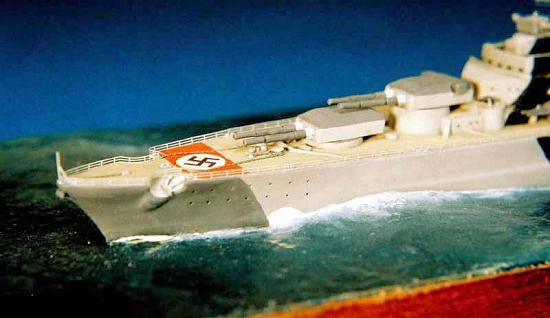 The wood
decks were excellent, with delicate molded plank detail and various hatches,
breakwaters, and assorted “deck gack” cleanly rendered. One small
problem here was on the
second deck between forward
superstructure and aircraft catapult, which Airfix had depicted as wood.
It was actually unplanked steel on the real ship, but a little sanding and
it was good to go. The configuration of the ground tackle and
forecastle deck was also a little off from my references, so I removed the
molded anchor chains and corrected the area as best I could. Airfix
did not provide anchors, so I fitted the ship with new photoetch anchors and
chains (Tom’s Modelworks 1/700 scale photoetched brass anchor set #724) both
here and at the stern.
The wood
decks were excellent, with delicate molded plank detail and various hatches,
breakwaters, and assorted “deck gack” cleanly rendered. One small
problem here was on the
second deck between forward
superstructure and aircraft catapult, which Airfix had depicted as wood.
It was actually unplanked steel on the real ship, but a little sanding and
it was good to go. The configuration of the ground tackle and
forecastle deck was also a little off from my references, so I removed the
molded anchor chains and corrected the area as best I could. Airfix
did not provide anchors, so I fitted the ship with new photoetch anchors and
chains (Tom’s Modelworks 1/700 scale photoetched brass anchor set #724) both
here and at the stern.
Next
came the weapons. The main 15 inch turrets, molded integrally with the
guns, came first.
These weren’t perfectly accurate, but the only changes made were to reduce
the thickness of the rangefinder “ears” (the kit parts came down too far)
and to hollow out the muzzles using the tip of a new #11 X-acto blade.
An additional alteration was to remove the “ears” entirely from turret
Anton,
the forward turret. Airfix depicted these in place, which was correct
for the ship as built. However, during initial trials the Germans
found them to be useless in that position due to seas over the bow, and they
soon removed them.
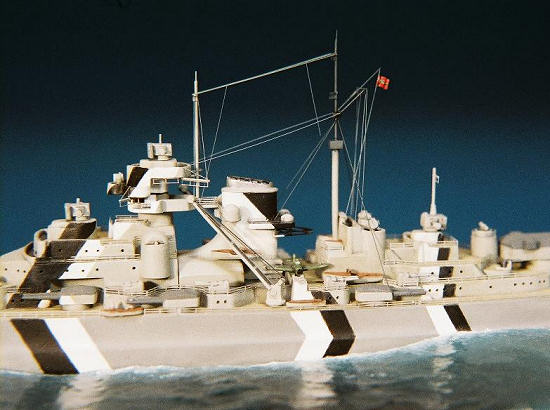 The
smaller
150mm secondary turrets were
similar to the main guns, except I didn’t hollow out the muzzles (a dab of
black paint at the ends is enough to fool the eye in 1/1200). The
105mm and 37mm antiaircraft guns were fine out of the box, just needing a
minimum amount of mold clean up. The kit omits the 20mm single mounts
entirely, but they would have been almost invisible in this very small scale
anyway.
The
smaller
150mm secondary turrets were
similar to the main guns, except I didn’t hollow out the muzzles (a dab of
black paint at the ends is enough to fool the eye in 1/1200). The
105mm and 37mm antiaircraft guns were fine out of the box, just needing a
minimum amount of mold clean up. The kit omits the 20mm single mounts
entirely, but they would have been almost invisible in this very small scale
anyway.
Sensors and fire
control fittings varied in quality. The 10.5m rangefinders atop the
superstructures were nicely depicted, the only improvements here being to
add small photoetched screen material to the radar faces. The armored
domes for the type 1937 rangefinders, on the other hand, were pretty poor.
I didn’t take the trouble to replace them with corrected spherical shapes,
but I did remove the domes from the aft mounts. The Airfix mold makers
probably used builder’s plans showing these in place, but in fact Bismarck
was rushed into service and the planned domes were never fitted to these
positions. I removed them and filled the empty mounts with parts
adapted from spare 1/700 Japanese destroyer rangefinders. The parts
box also yielded searchlights to fill empty positions near the mainmast and
on the main tower.
The ship’s boats,
cranes, and aircraft were ok from the kit, if lacking in detail. The
masts weren’t bad either, except that the mainmast was way too tall. I
ended up using only the lower half of it and fabricating the upper part from
portions of the kit part, copper wire, and leftover photoetch bits.
The other masts and rigging were made up in the same way. Some
additional detail for the aircraft catapult and the two small triangular
cranes on the after part of the funnel were also 1/700 scale photoetch
leftovers pressed into service.
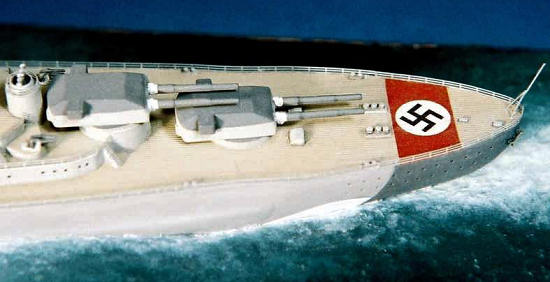 The most
fiddly part of the build was the railing. Now 1/1200 scale is very
small indeed (1 inch equals 100 feet!), and I’d never tried to rail a ship
this small before. Still, it would look very cool if I could pull it
off, so I ordered the only set I knew of designed for such a small scale,
Tom’s Modelworks’ 1/1250 3-bar photoetch brass railing. When the rails
arrived, I couldn’t believe it! These things were unbelievably fine,
consistent, and in-scale. The shiny brass parts were just beautiful,
and I couldn’t wait to try them out. I painted them up, cut out a test
section and glued it on and they looked, well… disappointing. What
happened? The rails were straight, consistent, and in-scale as
expected. The problem was, these things were actually
too
fine. Yeah, they were correct, but I could barely
see
those test runs once they were on! I decided to try another approach.
I had some 1/600 scale railing on hand (Gold Medal Models Merchant Ship
detail set #600-2), so I took a length of 4-bar rails from the set and cut
them down lengthwise to create 2-bar rails a little less than 1/16th
of an inch high. Though still small, these rails were somewhat less
delicate than the brass set—and looked much better. The stainless
steel photoetch was not easy to cut (my scissors were junk by the end of
this project), but these rails worked great. I liked this tougher
material, which was less prone to damage than the softer brass.
Methodically trimming each run down was not the most exciting of tasks, but
once cut the rails went on without any problems. And I was satisfied
with the final effect: busy, delicate, yet still clearly visible, even if
you do have to move in close to see it!
The most
fiddly part of the build was the railing. Now 1/1200 scale is very
small indeed (1 inch equals 100 feet!), and I’d never tried to rail a ship
this small before. Still, it would look very cool if I could pull it
off, so I ordered the only set I knew of designed for such a small scale,
Tom’s Modelworks’ 1/1250 3-bar photoetch brass railing. When the rails
arrived, I couldn’t believe it! These things were unbelievably fine,
consistent, and in-scale. The shiny brass parts were just beautiful,
and I couldn’t wait to try them out. I painted them up, cut out a test
section and glued it on and they looked, well… disappointing. What
happened? The rails were straight, consistent, and in-scale as
expected. The problem was, these things were actually
too
fine. Yeah, they were correct, but I could barely
see
those test runs once they were on! I decided to try another approach.
I had some 1/600 scale railing on hand (Gold Medal Models Merchant Ship
detail set #600-2), so I took a length of 4-bar rails from the set and cut
them down lengthwise to create 2-bar rails a little less than 1/16th
of an inch high. Though still small, these rails were somewhat less
delicate than the brass set—and looked much better. The stainless
steel photoetch was not easy to cut (my scissors were junk by the end of
this project), but these rails worked great. I liked this tougher
material, which was less prone to damage than the softer brass.
Methodically trimming each run down was not the most exciting of tasks, but
once cut the rails went on without any problems. And I was satisfied
with the final effect: busy, delicate, yet still clearly visible, even if
you do have to move in close to see it!
| COLORS & MARKINGS |
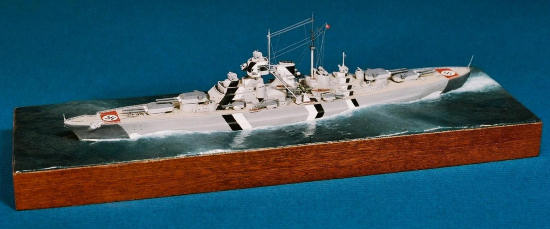 white
bands were supposed somehow to blend visually with the background at a
distance, or they might have been intended to make identifying the ship more
difficult by obscuring the ship’s configuration. In any case, U.S.
Naval intelligence assessment of the stripes’ effectiveness as camouflage
was scathing, dismissing them as “ineffective”. They still looked
kinda cool though!
white
bands were supposed somehow to blend visually with the background at a
distance, or they might have been intended to make identifying the ship more
difficult by obscuring the ship’s configuration. In any case, U.S.
Naval intelligence assessment of the stripes’ effectiveness as camouflage
was scathing, dismissing them as “ineffective”. They still looked
kinda cool though!
Finding paints to
approximate the various colors was not difficult. Model Master Italian Blue
Gray (lightened) was a reasonable match for
Silbergrau,
while Model Master Neutral Gray worked for
Fehgrau
and Model Master Gunship Gray stood in for
Anthrazitgrau.
I used a lightened Model Master Armor Sand for the wood decks, Model Master
French Khaki for the floatplane, and the boats were painted with Model
Master Military Brown. Out of sheer laziness I brush painted the
entire project, but if I were to do it again I would use the airbrush to get
a more even finish.
Bridge windows
were little squares cut from black decal scraps as were the vision slits in
the armored tower. The
Hakenkreuz air recognition markings are
decals from I-94 Enterprises
www.I-94enterprises.com (product GR-105, German
WWII Battle and Air Recognition Flags for 20mm-1/285 armor). These
aren’t 100% correct, as they should cover a larger deck area and the
swastikas shouldn’t have the quarter turn, but they still look good. I
had originally intended to use larger, more accurate panels adapted from a
1/48 aircraft decal, but the correct larger size tended to highlight the
model’s too-short fantail. The less accurate markings actually worked
better!
| CONCLUSIONS |
Airfix’s little
Bismarck is an attractive model, noticeably superior to the more widely
available Revell 1/1200 scale “Miniships” Bismarck/Tirpitz. If you
want a small scale Bismarck for your fleet (and aren’t bothered by a few
inaccuracies), this kit is an inexpensive, fun choice… but you’ll likely
have to troll e-Bay to find one!
| REFERENCES |
http://www.kbismarck.com/ A terrific
website with info on all things Bismarck including color profiles of the
ship and a great model gallery.
http://www.bismarck-class.dk/ Another
excellent website with lots of Bismarck info.
http://www.history.navy.mil/faqs/faq118-2.htm An interesting summary of the Bismarck sortie prepared by the U.S. Office of Naval Intelligence in 1942.
September 2008
If you would like your product reviewed fairly and quickly, please contact me or see other details in the Note to Contributors.